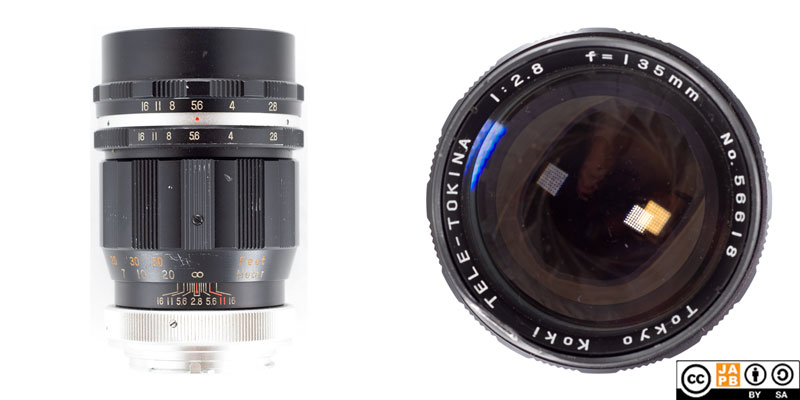Pekka Buttler, 07/2025

Specifications
The table below summarises the lens’ key specifications (measurements based on pictured sample, fitted with Minolta SR adapter ring):
| Brand: | Tokyo Koki (Tokina) | Lens name | TELE-TOKINA 1:2.8 f=135mm |
| Focal length(s) 1 | 135 mm | Angle-of-view 2 | 18° |
| Maximum Aperture | f/2.8 | In Production | 1960s |
| Lens mounts (native) | M47 | Other lens mounts3 (using adapter rings) | Canon FL, Canon FD, Exakta, LTM, M42, Minolta SR, Miranda M44, Petri FT |
| Length 4 | 90,4 mm | Diameter 5 | 61,6 mm |
| Filter ring diameter | 55 mm | Weight | 414 grams (with Minolta SR adapter) |
| Lens element count | n/a6 | Lens group count | n/a |
| Aperture blades (S/R/C) 7 | 15 S | Focus throw | 250 ° |
| Minimum focusing distance (measured) | 164 cms | Maximum magnification (measured) | 1:10,3 |
| Has manual aperture ring | YES | Has manual focus ring | YES |
| Aperture mechanism type | Preset | Aperture click stops (on preset ring) 8 | 2.8-4-5.6-8-11-16 |
Further notes:
• This lens was manufactured by Tokyo Koki Seisakusho (Today: Tokina) during the time when Tokina was first spreading its wings as an independent lens manufacturer.
• During that time Tokina tried several names, including “Tokyo Koki”, “Minetar”, “Tokina” and “Lucky-Tokina”. Hence, if you find a lens carrying any of these names, you’ve likely encountered an early Tokina lens
• This lens uses an M47 thread as an intermediate mount. See the JAPB article on the M47 mount for further details.
• This lens is a preset lens with a preset ring featuring full-stop clicks and a clickless aperture control ring.
Adapting
Given that this lens uses an intermediate mount, the first step is to either identify which adapter comes fitted to your lens (of if your lens arrived in your lap without a adapter, to procure such an adapter. If you do not yet have an adapter ring, we suggest procuring an M47->M42 adapter ring as that is likely easiest to find and opens the widest range of possibilities for adapting.
On dSLRs
If you have a Canon EF, Pentax K or Sony/Minolta A dSLR, and you have this lens with an M42 adapter ring, you can adapt your lens using a simple adapter ring. However, metering will only work in stop-down mode.
If your dSLR is uses a Nikon F mount or if your lens’ adapter ring is of any other type, adapting will only work using an adapter with corrective optics to make up for the negative flange focal distance difference.
On Mirrorless
Assuming you already have an adapter ring on your lens, the only thing that you need is an adapter from that mount to your mirrorless mount. Thanks to being a fully manual lens (manual aperture, manual focus), a simple dumb adapter is sufficient for photography. Also, some of the mounts that you can find adapter rings for, you will have a wide range of special adapters (e.g. helicoid adapters; tilt-shift adapters; speed boosters) available.
On Film
Depending on the adapter ring your lens has, it is more than likely that you can find a film camera that will support using the lens.
History of Tokina
Tokina was originally founded in 1950 by a group of ex-Nikon engineers, went out of business once, launched a successful intermediate lens mount and is one of the few Japanese postwar optics startups that has survived to this day. Sort-of, at least. Read more in the JAPB company profile on Tokina.
Footnotes
- Focal length is (unless stated otherwise) given in absolute terms, and not in Full-frame equivalent. For an understanding of whether the lens is wide/tele, see ‘Angle-of-view’. ↩︎
- Picture angle is given in degrees and concerns the diagonal picture angle. Rule of thumb:
> 90 ° ==> Ultra-wide-angle
70–90 ° ==> Wide-angle
50–70 ° ==> Moderate wide-angle
40–50 ° ==> ‘Standard’ or ‘normal’ lens
20–40 ° ==> Short tele lens
10-20 ° ==> Tele lens
5-10 ° ==> Long tele lens
< 5 ° ==> Ultra-tele lens ↩︎ - JAPB is here listing only those adapters that we have seen with our own eyes, but other period-typical adapters can also have existed. ↩︎
- Length is given from the mount flange to the front of lens at infinity. ↩︎
- Diameter excludes protrusions such as rabbit ears or stop-down levers. ↩︎
- I have found no hard evidence on the optical design used by the lens, but an educated guess would be some variant of the Sonnar recipe. ↩︎
- S=straight; R=rounded; C=(almost)circular at all apertures. ↩︎
- Numbers equal aperture values on aperture ring; • intermediate click; – no intermediate click. ↩︎